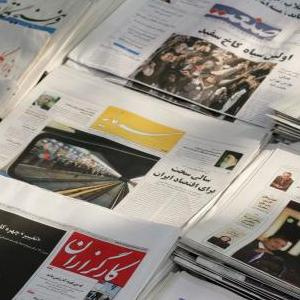Tehran's Daily Newspaper Review

It’s all about the 3 billion-dollar case of embezzlement, a blemish for the self-proclaimed squeaky-clean administration, which wielded allegations of corruption as its trump card against electoral contenders in the 2009 presidential run.
Economic experts interviewed by Iran call for avoiding political blarney changing the course of the embezzlement case. One governmental official called it a merely financial case whose politicization is against public interests. Iran published a photo Mahmoud Ahmadinejad extending his hand to well-wishers as he made his flight to New York to attend the annual UN General Assembly. “Dual Behavior” was the title of Ali-Akbar Javanfekr’s editorial-- not concerning the West’s attitude towards Iran's nuclear program, but the anti-Ahmadinejad faction’s treatment of the 3 billion-dollar case of embezzlement. Javanfekr reminded readers of the fact that the president handed a list containing the name of major financially corrupt figures to the judiciary in early 1390, which appears to have been shelved by the judicial apparatus, to juxtapose the related reactions and depict the paradoxical behavior of the government’s opponents.
Jomhouri-ye Eslami’s banner headline addressed the backstage of the 3 billion-dollar embezzlement in a closed session report presented by Head of the General Inspection Organization (Mostafa Pour-Mohammadi, Minister of Interior in Ahmadinejad's first administration.) The NY police department’s blocking of Wall Street to prevent the Americans’ “day of rage” was also covered by the newspaper. Jomhouri-ye Eslami’s editorial tried to identify the cause of embezzlements happening in Iran's economy. The imbalance in the supply-demand chain of the banking system, a product of Ahmadinejad's economic policies according to the author, and laxity in setting regulatory standards have helped the creation of a fertile ground for corruption, the editorial maintained.
Kayhan used its typical 72 font to quote “intellectuals attending Tehran [Islamic Awakening] Conference,” stating that the Leader of the Iranian Revolution illustrated the road map for regional uprisings. Nineteen suspects have been arrested in connection with the 3 billion-dollar embezzlement case, the newspaper reported. Kayhan also published Mahmoud Ahmadinejad's comments in the closing ceremony of the Tehran Conference where he assured Middle East nations that they have the backing of the Leader, the Iranian nation and the government. The editorial made efforts to link the embezzlement case to Esfandiar Rahim Mashaei and his team’s adverse policy towards the Islamic Awakening transpiring in the region.
Resalat quoted Mohseni Eje’i, Prosecutor General assigned by the Chief Magistrate to handle the embezzlement case, saying that 19 main suspects in connection with the fraud have been detained. Eje’i also warned that the judiciary won’t allow powerful figures to evade prosecution through “quasi-legal” measures. Parliamentary Speaker Ali Larijani also described the fraud case as an effort to undermine the national economy. Iran is categorically against any plans to disintegrate Palestine, Resalat quoted FM Ali-Akbar Salehi.
“Resign,” Shargh quoted Ahmad Tavakkoli, Tehran MP and a trenchant critic of Ahmadinejad's policies. Tavakkoli addressed the government following the report presented to Majles by Mostafa Pour-Mohammadi on the embezzlement case. Shargh also cited Vice President Mohammad-Reza Rahim, under heavy attack himself for corruption allegations by key Principlist figures less than a year ago, as saying that “the government spearheads the anti-corruption battle.” Half of the newspaper’s headlines revolved around the outrageous fraud, plus the editorial, written by Reformist economist Saeed Leylaz, who expressed concern that the bedlam created over the scandal may cloud the roots, which he enumerated as arbitrary measures of the government regarding economic issues, dissolution of supervisory and regulatory bureaus, and the partisan attitude towards economic corruption.
“You’re asking too many questions” said the Minister of Economy to Tehran-e Emrooz’s correspondent. Majles’ closed session held yesterday was described as “Disclosure Day for the Great Embezzlement” by the newspaper. Effective reaction, effective punishment and adopting preventive measures are three steps to be taken to return public trust and render the administrative machine transparent, according to the newspaper’s editorial.
Vatan-e Emrooz preferred to focus on the demonstrations in the vicinity of Wall Street and speak of New Yorkers’ anger against capitalistic policies. Iran will vote in favor of Libya’s National Transition Council, Vatan-e Emrooz quoted Foreign Ministry Speaker Ramin Mehmanparast. The newspaper also published remarks by the new Oil Minister, Rostam Ghasemi, who promised to develop 27 new oil fields.
* Notes:
The editorial section of Iranian newspapers is not always the work of the editor-in-chief or the senior editorial staff of the newspaper, but can be a contribution by experts and politicians (typically agreeing with the newspaper’s political stance.)
Vatan-e Emrooz daily does not publish on Thursdays.
Trouble with understanding some terms? Check our Glossary of Iranian Political Terms.
Briefing
Hamshahri (Citizen) is the official daily newspaper of Tehran's Municipality. Its general directions in politics, culture and economy are determined by the mayor of Tehran, currently Mohammad Baqer Qalibaf.
Iran is the official organ of the administration.
Jomhouri-ye Eslami (The Islamic Republic) was known as the official organ of the Party of the Islamic Republic, founded in 1979 and disbanded in 1987. Currently, it is an open critique of Mahmoud Ahmadinejad's policies and is known to be a mouthpiece of Akbar Hashemi Rafsanjani.
Kayhan (Universe) is a hard-line conservative newspaper. Its editor-in-chief –currently Hossein Shari’atmadari- is appointed by Iran's Supreme Leader. Shari’atmadari’s editorials often spark off controversy and debate inside Iranian political circles.
Khabar (News) is a principlist daily newspaper which adopts a critical stance towards Ahmadinejad's policies.
Resalat (Mission) belongs to the moderate wing of the principlist camp. Resalat’s best known analyst is Amir Mohebbian, its political editor.
Shargh (East) is a moderate reformist newspaper. It was the most popular and influential reformist newspaper in its first period of publication which lasted from August 2003 until September 2006.
Tehran-e Emrooz (Tehran Today) is a ‘principlist reformist’ newspaper, connected to Mohammad Baqer Qalibaf.

